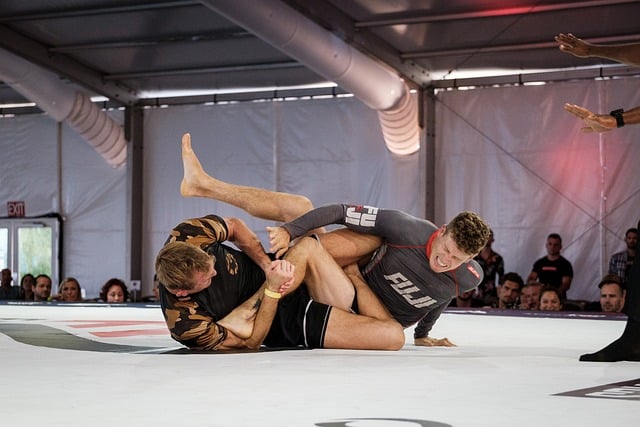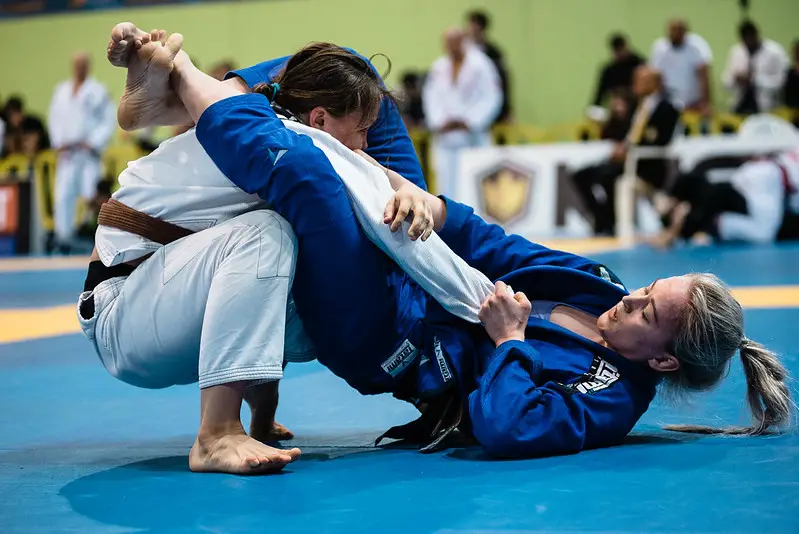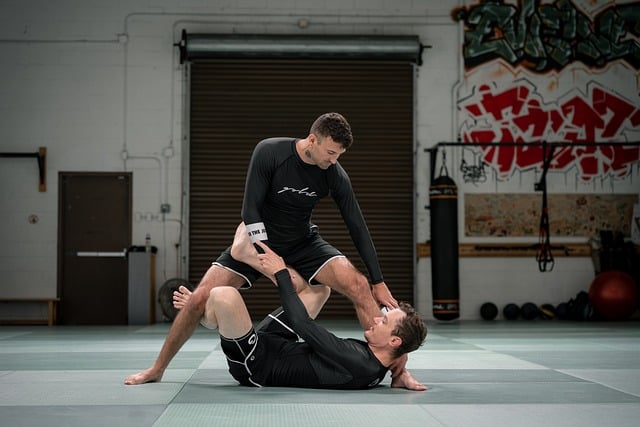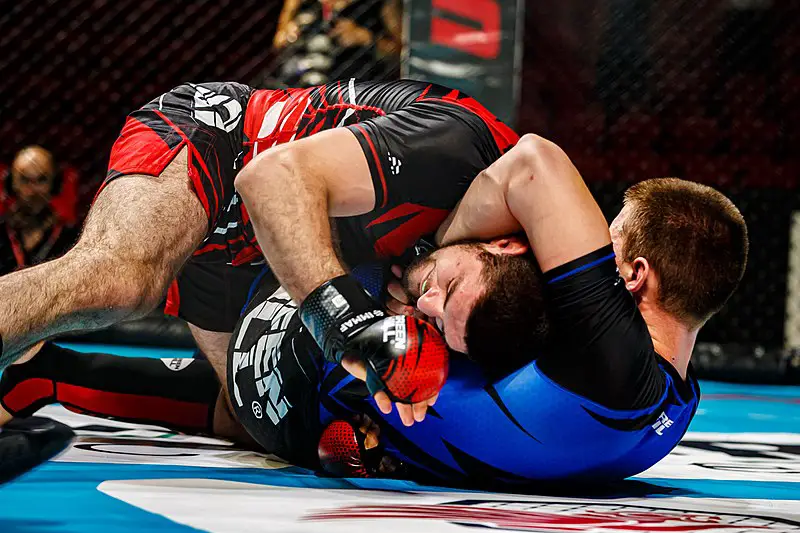BJJ is widely regarded as one of the most popular martial arts. But how practical is BJJ in real life? Is BJJ Effective for Self-defense?
Yes, BJJ is effective for self-defense, and using its skills improves your chances of neutralizing the threat. Its practical throws, chokes, and locks work in a real fight, notably in close-range combat.
Above all, it is a rare system that works regardless of the physical disadvantage.
In this article, we will take a closer look into how effective BJJ is for self-defense, as well as all the pros and cons of training.
Is BJJ Good For Self-Defense?
BJJ as a concept is highly effective for self-defense. The learning program is in line with the physical and mental demands of real fighting, and it increases your fighting abilities. Training is:
- Realistic as it focuses on sparring
- Trains your instincts to perform under pressure
- Teaches you emotional control
- Improves muscle memory
On the feet, BJJ teaches how to expect the attack and counter with throws, trips, or sweeps. On the ground, you learn how to manoeuvre into a dominant position to establish control. Then, you can neutralize the threat using different holds, chokes, or joint locks.
Though the process may seem complex, it all happens within a few seconds.

The system is practical as it relies on technique, leverage, balance, and strict procedures. For instance, an untrained opponent has zero chances of defending a well-time throw. They can’t rely on sheer power to prevent a throw or muscle their way out of the bottom. This requires years of training.
This makes BJJ good for self-defense that involves close-range combat such as inside the bar or hall.
But above all, BJJ for self-defense enables you to win a fight without causing serious injuries. Students know how to manipulate the force to keep the opponent safe, yet immobilized?
How To Use BJJ For Self-Defense?
BJJ equips practitioners with practical techniques and skills they can use in the real world in a self-defense situation. the system trains you to use advanced combat methods to quickly advance to the ground and neutralize the attacker with pins, holds, or submissions. Here is a detailed explanation of all the methods.
Fits well in a chaotic environment
Jiu Jitsu works well at close range where you can quickly secure a strong grip on the attacker. Most street fights include a lot of grabbing, pushing and intense pulling on the joints. Though intense, this is an environment in which skilled jiu-jitsu practitioners operate the best.
It gives them many opportunities to grab the attacker, and execute a trip, throw or takedown. Just a solid grip and proper positioning is often more than enough for any BJJ fighter to get a takedown.
Ground Fighting Skills
BJJ is great for self-defense because it teaches you how to handle situations when things go to the ground. You learn moves to control and stop opponents, which is crucial since many real-life fights end up on the ground.
On top of that, most people don’t know how to grapple which gives you big advantage. Even if they are trained strikers, most of them would look lost and confused on the ground with you on top. You can rely on your skills and sparring experience to quickly establish strong control and submit them.
Adaptable Techniques
BJJ is flexible – it helps in both standing and ground situations. It’s handy when dealing with different types of attackers. You don’t need to be big and strong as the system focuses on using smart moves to defend yourself.
In training, you will learn how to maximize you strengths and minimize weaknesses in real combat. It doesn’t matter if you are tall, short, big or small, everyone can get the most out of their physicality as all techniques are adaptable.
Works Against Bigger Opponents
Even if your opponent is bigger, BJJ teaches you tricks to use their size against them. It’s not about being strong; it’s about being clever and knowing how to handle yourself.
Yes, bigger opponents may overpower you down to the ground regardless of skill difference. But, you can use attacking moves off your back to quickly set up a submission or reverse the position.
Realistic Practice
In BJJ classes, you practice in a way that feels like a real fight. This helps you stay calm and make good choices in a stressful situation.
Students spar on a daily basis which significantly improves their muscle memory, reactions, and instincts. Once in a real fight, daily sparring enables you to perform on autopilot without even thinking about it.
Control Without Hitting
BJJ is not about punching or kicking. It’s more about controlling the situation without causing harm. This can be useful when you want to stop a threat without getting into more trouble.
Why BJJ is NOT Good For Self-Defense?
Though Jiu-Jitsu is good for real combat, it is also important to be aware of its limitations. This includes the lack of striking techniques and proper self-defense training such as against multiple attackers or weapons.
Let’s take a closer look at each one:
Lack of striking techniques
Most fights begin with one or more persons swinging a punch. This is the most natural and efficient way you can hurt a person in front. Thus, knowing how to block, dodge/slip the punch, or check a kick is an essential skill.
However, the BJJ learning syllabus doesn’t include any striking. Not even on the basic level and this is a major drawback. Yes, grappling skills are a big plus in a fight. But you still need to know how to deal with the strikes.
Heavy emphasis on competition
Traditional BJJ was created as a self-defense system. But over time, the emphasis has shifted from real fighting to competition. As a result, modern practice is designed to be in line with the official rules.
Instead of learning how to fight, practitioners learn how to compete under the rules and win matches. This very much decreases the overall effectiveness of the system because there are no rules when your life is in danger.
No advanced self-defense training
Fighting in the real world is fraught with danger. There are so many variables, things that may happen and go wrong, and you just can’t prepare for them all. That’s why proper self-defense training is needed.
You need to know how to react against multiple opponents, weapons, and specific scenarios. Specific drills to train your instincts, awareness, decision-making, etc.
Modern jiu-jitsu practice doesn’t have any of that. The entire focus is on competitive grappling with little to no time dedicated to real self-defense training.
Traditional BJJ was different on the other hand. It used to include advanced tactics and even striking. However, you will have a hard time finding a traditional school to train in.
Gi or No Gi BJJ For Self-Defense?
Both gi and no-gi Brazilian Jiu-Jitsu (BJJ) can be effective for self-defense, and the choice between the two depends on various factors, including personal preference, training goals, and the specific street fighting scenarios you envision. Here are some considerations for each:
Gi BJJ for Self-Defense
- Clothing Simulation. Training with a gi allows practitioners to simulate real-world situations more accurately, as the gi resembles everyday clothing. This can be beneficial for learning how to use an opponent’s clothing for control and against the attacker.
- Grip Control. The gi provides additional handles and grips, which can be advantageous for controlling an opponent. Learning how to break and maintain grips can be useful in self-defense scenarios.
- Traditional Aspects. Gi training is rooted in tradition, and some practitioners appreciate the cultural and historical aspects associated with traditional martial arts.
Patience and Control: Gi BJJ often requires more patience and control due to the additional grips and options for positional control. This can be beneficial in self-defense situations where avoiding unnecessary escalation is important.
No-Gi BJJ for Self-Defense:
- Faster Pace. No-gi training tends to be faster-paced and more dynamic. This can be advantageous in situations where quick movement and transitions are crucial.
- Applicability to Real-Life Clothing. No-gi training can be more directly applicable to scenarios where an attacker may not be wearing a gi or similar clothing. The techniques learned in no-gi can be adapted more easily to a variety of clothing situations.
- MMA Considerations. If your self-defense goals involve preparation for mixed martial arts (MMA) scenarios, no-gi training may be more relevant, as it closely aligns with the grappling aspects of MMA.
Ultimately, the effectiveness of gi or no-gi BJJ for self-defense depends on the practitioner’s ability to adapt techniques to the specific circumstances they may encounter.
Is BJJ Good For Beginners? (Expert Analysis)
BJJ Self-Defense For Women
Jiu-jitsu is beneficial for women looking for self-defense training. The concept increases their combat abilities in a fight, more than other systems. Many women see it as ideal as it enables a physically small individual to defeat a bigger opponent.
As you would assume, this makes it effective for women who often get attacked by a physically bigger man. In these situations, going power vs power does not work. And this is where BJJ’s focus on technique and leverage comes into play.

On the feet, women trained in BJJ know how to move to protect their range and balance, break grips, hand control, and even execute a takedown. Size doesn’t play a big factor as a perfect execution can throw anyone off balance and to the ground.
Even if you end up on the ground and in an inferior position, it is far from over. Women trained in BJJ can rely on escapes to work their way up or even reverse a position. They can attack using joint locks to place an armbar, or triangle choke to neutralize the threat.
No matter how big the opponent is, they would have a hard time escaping. If they end up in an armbar, trying to muscle their way out is going to result in an injury.
Conclusion – Can You Use BJJ For Self-Defense?
BJJ is more than practical for self-defense and you can use its techniques and other skills to protect yourself in real-life situations. Despite the limitations, the system works well in most scenarios, especially in the ones including fighting at close range.
Overall BJJ has strengths that make it effective for self-defence. But it’s essential to consider the following points.
The system excels in ground fighting, which is a common scenario in self-defence situations. It teaches practitioners how to control and neutralize opponents on the ground. Next, training emphasizes technique and leverage and this enables you to deal with bigger opponents. This is crucial for the real world where there are no weight classes.
Also, regular sparring provides realistic training scenarios. It helps practitioners develop the ability to stay calm and make good decisions under pressure.
However, BJJ won’t teach you de-escalation techniques, how to deal with multiple attackers or striking. These are the major limitations and to develop proper skills, you would need to cross-train in other arts.
How Effective is BJJ In MMA?



Pingback: Best Martial Arts Without Striking (Top 8) - MMAEscape